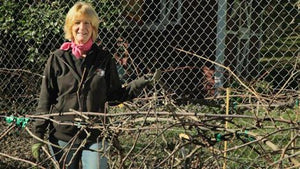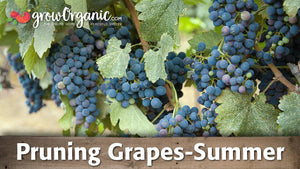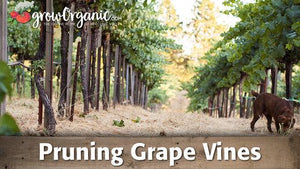Item Number: FV040
Pinot Noir Wine Grape Vine
Grow Premium Pinot Noir Grapes at Home
Mix-and-match for free shipping when purchasing 6 or more perennial berries, vines, or crowns!
Pinot Noir Wine Grape Vine – Highest Quality Home Vineyard Choice
Looking for Pinot Noir vines for sale that offer elegance, flavor, and premium winemaking potential? The Pinot Noir Wine Grape Vine is a top-tier grape variety prized for its thin skins, vibrant red cherry flavor, and versatility in both still and sparkling wines. Known for its refined style Pinot Noir profile, this vine is a favorite among wine enthusiasts and home gardeners alike.
Key Features
- World-Class Grapes: Grow authentic Pinot Noir grapes, celebrated for their delicate skins, balanced acidity, and flavor complexity.
- Cool Climate Performer: Ideal for cooler regions that also support Pinot Gris, Pinot Blanc, and classic regions like Gevrey Chambertin.
- Compact & Versatile: Great for small vineyards, containers, or backyard trellises—perfect for the serious home vineyard grower.
- Fragrant Blooms: Aromatic flowers attract pollinators and add beauty to your garden.
Growing Essentials
- Sunlight: Needs 6–8 hours of full sun daily.
- Soil: Prefers slightly acidic, well-draining soil rich in organic matter.
- Watering: Keep soil consistently moist during dry periods; avoid soggy conditions to prevent root rot.
- Hardiness: Grows well in USDA Zones 4–9. In colder climates, it may need protection—like a cover or indoor storage in winter.
- Fertilization: Use a balanced fertilizer during the growing season to encourage healthy vines and fruit production.
Why Choose This Pinot Noir Grape Variety?
This vine is perfect for winemaking at home, producing wine from Pinot Noir grapes that carry signature aromas of red cherry, cherries, and raspberries. The wine produced reflects the best Pinot Noir clones used in legendary regions like Gevrey Chambertin. It's also excellent for eating fresh or juicing.
Though difficult to grow, especially when compared to sturdier types like Cabernet Sauvignon, it rewards careful growers with unmatched elegance and complexity.
Care Tips for Success
- Pruning: Trim regularly to improve sunlight exposure and air circulation.
- Support: Use a strong trellis or vine support to guide healthy growth.
- Pest Management: Watch for mildew, aphids, and other common grapevine pests.
- Winter Protection: In frosty areas, shield your vine from extreme cold.
From Vine to Wine – Your Pinot Noir Journey Starts Here
Whether you're dreaming of homemade sparkling wines, crafting still reds, or just want to grow a cool climate favorite, this vine is a premium pick. For growers searching for Pinot Noir vines for sale that deliver the highest quality, this elegant grape variety offers everything—from bold fruit to a true style Pinot Noir experience. Browse our full selection of grape vines for sale to find the perfect variety for your vineyard or garden.
Visit our Berry, Vine & Crowns Characteristics Chart to compare growing characteristics for all our berries, vines, and crowns.



Check Your Zone Compatibility:
Compatible with your zone.
Growing Zone for

Our Guarantee To You
Since 1976, we've served our customers at every stage of growing. Please contact us at any time. We are happy to support and assist you.
Shipping Information
Shipping Information
Cannot ship to the following states: HI , AK , PR , GU , VI , OR , WA , ID
Cannot ship via USPS.
Cannot ship via SmartPost.
Shipping Weight: 3.3 lb
Dimensions: 18.0"L x 3.0"W x 3.0"H
Features
Features
Characteristics
Characteristics
Planting & Care
Planting & Care
Useful Information
Useful Information
Guarantee
Guarantee
Limited Dormant Tree & Plant Guarantee
* Claim deadline is June 15th
We guarantee that your dormant tree or plant will arrive in good, viable condition. If your tree arrives in substandard condition, notify us within 3 days of delivery. Please email pictures of the box, inside packaging, the tree and its roots to helpdesk@groworganic.com. We will investigate your claim and process a request to exchange or refund the damaged product.
If your dormant tree or plant has not grown new leaves by June 15th, you may be eligible for our Limited Dormant Tree & Plant Guarantee. This guarantee provides for a store credit for the purchase price of the tree, excluding shipping. Please see the Instructions below.
Important Dates:
- April 1st Dormant trees/plants must be planted in the ground
- May 15th Perform scratch test, if no new leaves have grown
- June 15th Deadline to apply for a dormant tree/plant credit
All required documentation must be received by June 15th for your claim to be considered. Claims or documentation received after June 15th will be denied, without exception. Instructions listed below
Terms and Conditions
We cannot guarantee that your tree or plant will remain alive and healthy after it is received, or bear fruit as there are too many variables in your environment that are beyond our control (i.e. soil preparation, weed and pest control, proper irrigation, chill hours, compatible hardiness for your growing zone, proper choice of pollinator, extreme weather, rodent damage, disease, etc.).
We cannot guarantee that we will be able to provide a replacement tree/plant of the same species either that same growing season or in future years. Customers are responsible for all shipping fees associated with replacement trees and plants.
If we determine that the tree you purchased directly from us is not viable, we will issue you a store credit (not a refund) for the purchase price of the affected dormant tree or plant. Shipping is not included in the dormant tree/plant guarantee. Store credits can be used to purchase any product we sell and are valid for use only until July 1st of the following year.
Historically, 98% of our dormant trees and plants grow and thrive when they have been cared for and planted using our growing guides. Dormant trees and plants must be planted in the ground by April 1st in order to be eligible for credit. If the ground in your area is still frozen solid, you may temporarily plant your tree or plant in a pot.
Potted, non-dormant trees or plants are excluded from this guarantee as they are not dormant at the time of shipment. Evergreen trees such as citrus, avocado and olive trees are not available for credit under the Dormant Tree and Plant Guarantee.
Instructions
We guarantee that your dormant fruit tree or plant will leaf out, if you care for it according to our growing guides. In the unlikely event that your dormant tree or plant does not have leaves by May 15th, follow these simple steps to apply for a store credit:
Before you call or email, please perform a “scratch test” to determine if the tree or plant is still alive. This video shows how to check for live tissue under the bark. Scratch tests need to be done a few inches above and below the graft.
Green Cambium Layer / Living Trees
If the cambium layer under the bark is green, give your tree a little more time. It is still alive, but hasn’t come out of dormancy yet. Check to make sure that it is getting the right amount of deep root water, enough sunlight and that the weather is warm enough for that type of tree/plant to come out of dormancy. Every tree has its own personality and will come out of dormancy at different times. Be sure to submit the required documentation listed below by June 15th, if it doesn’t grow leaves.
Brown Cambium Layer / Dead Trees
If the scratch test shows a brown cambium layer or if your dormant tree/plant doesn’t have leaves by June 1st, please email us at helpdesk@groworganic.com. All required documentation listed below must be received by June 15th for your claim to be considered. To be considered for the guarantee claim, all required documentation must be received by June 15th. Incomplete submissions will be denied.
Required Documentation
- Order number
- Name of dormant tree/plant and the quantity affected
- Photos of each tree or plant showing:
- The roots (tree or plant must be pulled out of the ground)
- The scratch test areas
- The entire tree/plant
We reserve the right to not issue credit for items that have already been replaced. We also reserve the right to require photographic evidence that the tree/plant was not killed by root rot, rodent or mechanical damage.
Share

Purchased two these as an experiment to grow in Texas. Vines arrived well packed and undamaged in January. They were heeled for about two weeks before being planted in their permanent home. From the ground, they were about 2 feet - 2.5 feet tall. I trimmed the entire vine back to start from scratch. Growth started in early March.
I can confirm that these are strong vines without any disease. Very happy with the purchase.
I always get good plants from Peaceful Valley. Dormant plants with thick stems and good roots.
Vines arrived on time and ready to plant. So far so good.
Received quickly and well packaged bare root plants. Have been planted and appear to be growing
Videos
Articles
-
 Sun, Jan 07, 2024
Sun, Jan 07, 2024Planting & Growing Grapes
-
 Wed, Mar 12, 2025
Wed, Mar 12, 2025When to Plant Grapes: A Complete Guide to Planting Grapes in Clay Soil and Beyond
-
 Thu, Jul 03, 2025
Thu, Jul 03, 2025Trim Grapes in Summer With Confidence: Learn How to Trim Grape Vines in Summer and the Secrets to Pruning Grape Vines During Growing Season
-
 Thu, Feb 06, 2025
Thu, Feb 06, 2025Planting & Pruning Grape Vines









